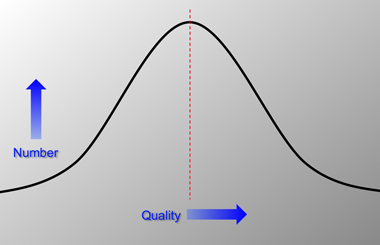In almost every sphere of human endeavour, the outcome can be plotted on a bell-curve – a few really skilled people over on the right, a few really hopeless people over on the left and a whole bunch or just-above or just-below average people in the middle:
I suspect that the curve for presentations looks more like this:
Why?
Seriously. Why?
How hard could this be? You get someone who knows what they are talking about standing up in front of a audience, with a bunch of visual aids to make the job of imparting information easier, and they impart the information. How hard could that be?
I have been involved with presentation at a professional level for over 20 years. If I include my earliest experiences with presentations – people teaching me stuff in primary school – then the figure is closer to 40 years. And the vast majority of them were dreadful. Teachers, coaches, lecturers, tutors, trainers, consultants – most of them suuuuuuuuuuuucked!
Think back. Put aside all your experiences in the world of work for a moment and just think back to your schooldays. How many exceptional teachers did you have in your 14 years of primary and secondary schooling? I had four excellent teachers in primary school and three in secondary, out of a total about 80 people who taught me various subjects between the ages of 4 and 17. Now, for our normal distribution bell curve, 7 out of 80 is about right, but it still sucks when you have to sit through it. And that’s before I even got to college, much less the world of work with all of its woeful presenters. Why does this happen? By dint of the fact that the person is up at the front of the room with the slides flickering behind him or her, they must be some kind of expert on their topic, whether that topic is the 3Rs in primary school or Web 2.0 marketing. So their expertise in the topic is rarely the problem.
I have gradually come to the realisation that the biggest problem with presentations is that human beings are simply too self-involved for the process to work well. Presenters are so wrapped up in themselves and their topic that they rarely seem to take a moment to consider what would be the best method for imparting this information to their audience. Audiences are so deluged with advertising messages and radio jingles, with phone calls, voicemail, email, SMS and IM, with… stuff in their personal lives that unless you, the presenter, are wowing them with every word, you will lose their attention in a matter of seconds.
Add to that the fact that the bar has been lowered to such an extent that most audiences are resigned to expecting dull, rambling, semi-legible, bullet-point-ridden presentations, and it’s not hard to see how we have arrived at this low ebb in communication.Both sides are at fault, to be sure; but if you are scheduled to make a presentation soon, you can control only one side of the conversation. Exercise that control. You have no say regarding the audience’s mood or willingness to listen, but you control your presentation, and in this series of posts, I will provide you with the knowledge, tools and approach to maximise your chance of success.
The psychologist and philosopher William James said, “The deepest human need is the need to be appreciated.” If your presentation is going to have any chance of success, it needs to be built on this understanding. As a starting point, I recommend some detox to clear your body and mind from a lifetime of exposure to sucky presentations. I strongly recommend that you expose yourself to some great presenters:
Check out Seth Godin, Tom Peters, Guy Kawasaki, Steve Jobs, and Dick Hardt on YouTube. Have a look at some of the wizards on TED.com – Rives, Hans Rosling, Barnett Thomas, Lawrence Lessig and Ken Robinson all stand out, but there are reams more on this invaluable resource. Go over to Common Craft and have a look at their ‘plain English’ tutorials on aspects of Web 2.0
The one common theme that emerges from this tremendous diversity of presenters, topics and styles is RESPECT. By every word and deed, they demonstrate absolute respect for both their audiences and themselves. A good starting point. The essential starting point. Next: Planning your presentation. Featured photo credit: Jason Goodman via unsplash.com

